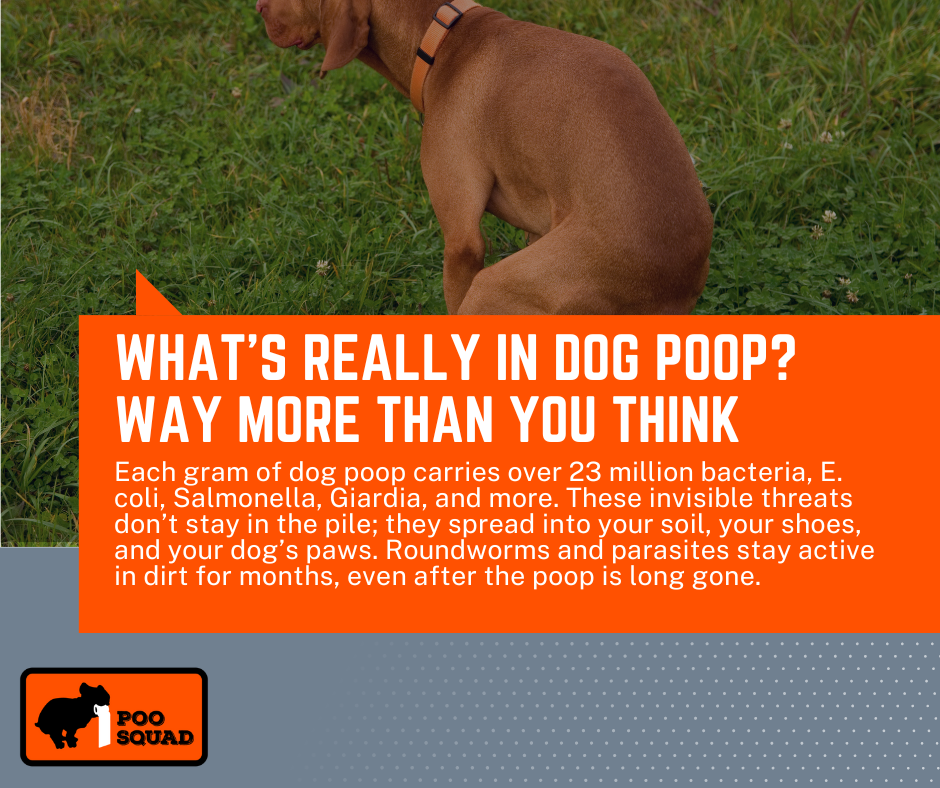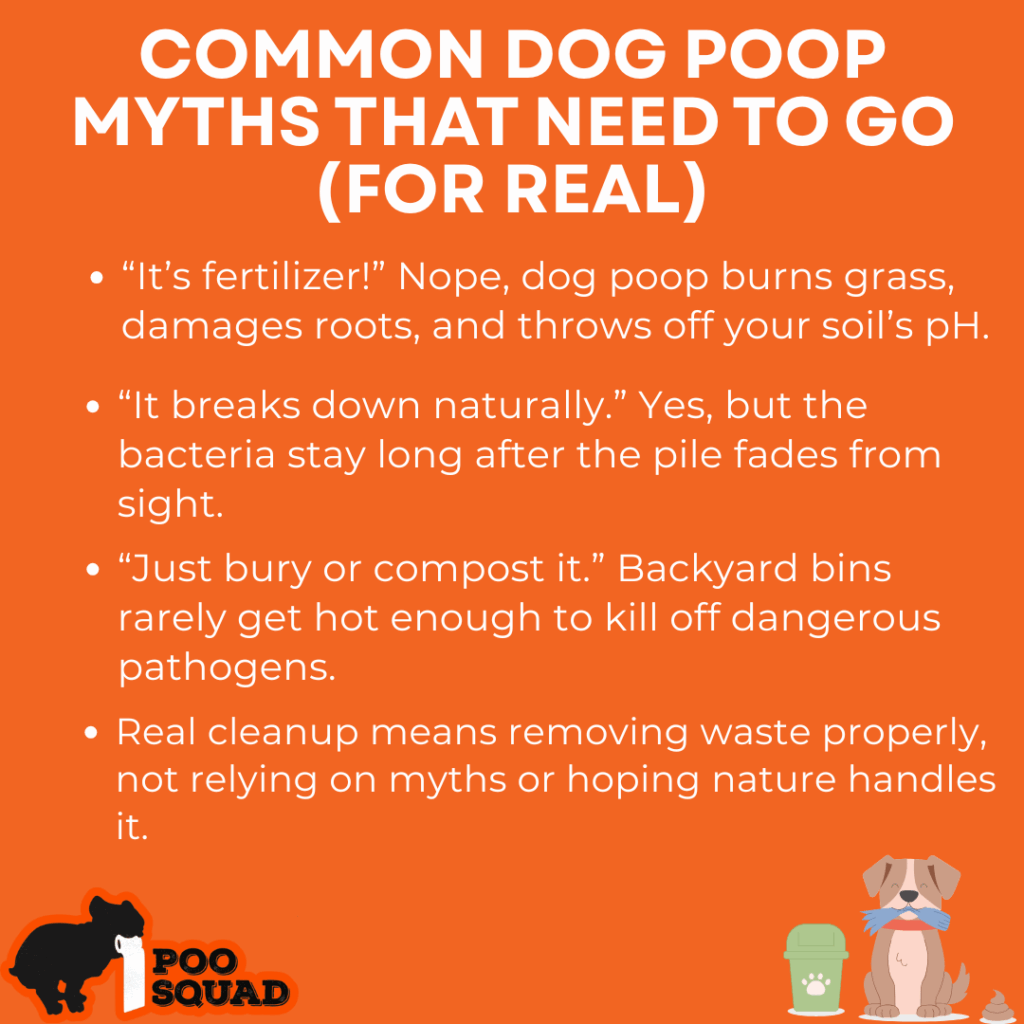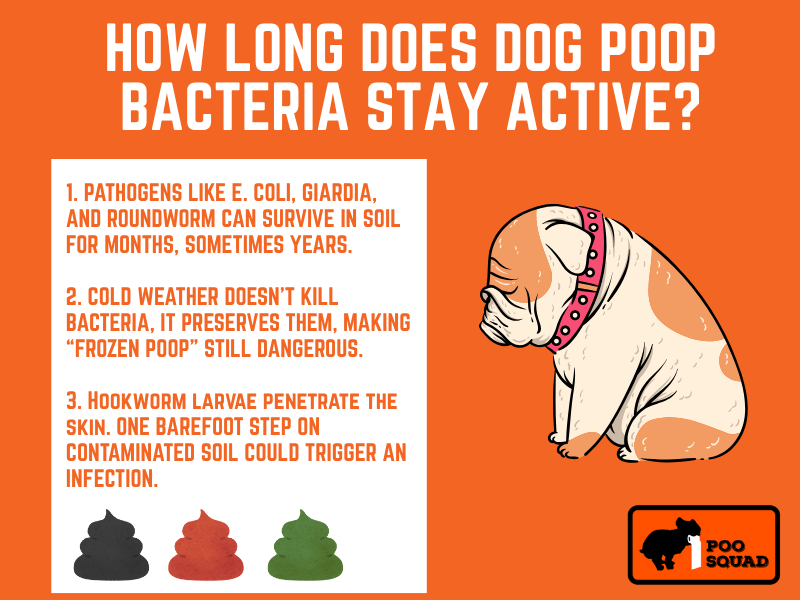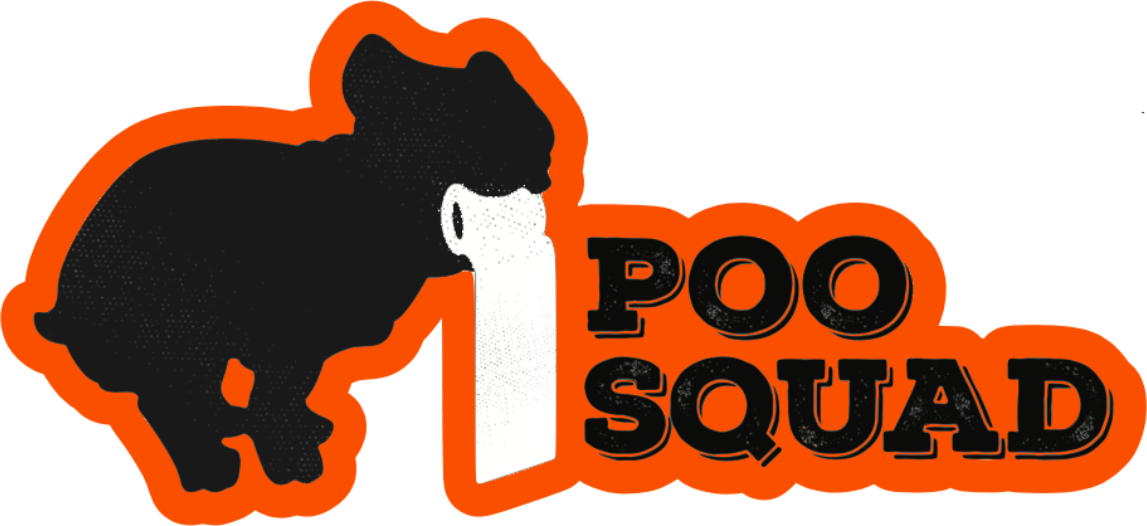How Much Bacteria Is in Dog Poop? Health Risks & Safety
Dog poop contains over 23 million bacteria per gram, including harmful strains like E. coli, Giardia, and Salmonella. Left uncollected, it spreads through soil, shoes, air, and even water, posing serious health risks to people and pets in shared outdoor spaces.
Dog poop carries more than 23 million bacteria per gram, and many of them are dangerous. From E. coli to Giardia, these microbes don’t stay put. They spread through soil, on shoes, into homes, and even into the air. This is not compost, it’s a public health concern.
One missed pile in the yard can turn into invisible contamination on your floors, your kids’ hands, or your pet’s paws. The problem is not only that poop is left behind, it’s how long its bacteria survive and how easily it travels.
Rain washes it into storm drains, bare feet absorb it through skin, and lawnmowers aerosolize it into what some call “poop dust.”
Whether you’re a parent, a pet owner, or a property manager, knowing what’s actually in dog waste and how it behaves is critical. Below, we break down what bacteria are hiding in a single pile, how long they last, who’s most at risk, and the steps you can take to protect your space and the people who share it.
What Types of Bacteria Are Found in Dog Poop?
Dog waste may look like an outdoor nuisance, but it’s a microbiological bombshell. Each gram teems with bacteria and parasites that can harm people, pets, and the environment. These aren’t fringe risks; they’re part of everyday exposure in neighborhoods where poop pickup gets ignored.

Coliform Overload: The 23-Million Count
Every single gram of dog feces carries upwards of 23 million coliform bacteria. That includes strains like Escherichia coli, a gut-dwelling organism that can lead to infections in humans when it finds its way into the mouth, nose, or open cuts. And if that sounds dramatic, ask any toddler parent how often backyard dirt ends up in little mouths.
Dangerous Pathogens That Can Harm You
In addition to coliforms, dog poop often contains Salmonella, Campylobacter, and Clostridium difficile, all of which can cause severe digestive issues in humans.
On top of that, parasites like Giardia and Cryptosporidium thrive in moist feces and survive in soil for months. Their presence often goes unnoticed until symptoms like diarrhea or fatigue show up weeks later.
For families trying to maintain safe outdoor play areas or clean gardens, understanding the scope of these pathogens is critical. This is especially true if you live in shared spaces or communities where poop frequently goes unmanaged.
Our commercial dog waste removal services were built for these exact challenges.
Parasite Alert: What’s Invisible in Poop?
Not all threats are bacterial. Roundworms, hookworms, and whipworms are common in dog waste and don’t require visible feces to spread. Their eggs embed into the soil and lie dormant until skin contact or ingestion triggers infection. This is particularly risky for children, seniors, and immune-compromised adults.
How Does Dog Poop Spread Bacteria?
Dog poop doesn’t need to move for its bacteria to travel. Whether it’s soaking into the soil, catching a gust of wind, or clinging to your shoes, the bacteria don’t stay where they land. It spreads, silently, steadily, and often without you realizing it until someone gets sick.
On the Ground: Lawn, Soil, and Sand Contamination
Once dog waste breaks down, it seeps into your yard’s topsoil, carrying bacteria and parasite eggs with it. That contamination lingers far beyond the life of the feces itself.
Even after the pile is gone, the lawn may remain hazardous, especially for barefoot kids or dogs who roll around outside. In areas like playgrounds or community spaces, that leftover bacteria can pose risks for months.
When we provide yard sanitizing and deodorizer services, it’s not because people are lazy; it’s because even responsible dog owners miss things. And the consequences of what’s left behind aren’t worth the gamble.
In the Air: Poop Dust & Inhalation Risks
In colder climates, studies found that up to half of the airborne bacteria came from fecal sources. That means when you step outside, you may be breathing in trace amounts of dried dog waste, especially in densely populated pet areas. And no, it doesn’t matter if it’s winter. Cold weather preserves bacteria longer, making it more likely to go airborne as poop dries and crumbles.
On Your Shoes, Rugs, and Floors
Think you’re safe indoors?
Not quite. Poop bacteria cling to shoes, pet paws, stroller wheels, and even your leaf blower. Once it’s on your soles, it’s on your floors, your carpets, and your kids’ socks. This is one of the reasons our team wears protective footwear covers and sanitizes all tools between yards. It’s not about appearances, it’s about not bringing someone else’s mess into your space.
What Happens When You Don’t Pick It Up?
Leaving dog poop behind is never a neutral act. It doesn’t fade away, it multiplies. Uncollected waste creates a chain reaction, from backyard infections to city-wide contamination, especially during rainy seasons or in neighborhoods with heavy foot traffic.
Water Contamination & Storm Drain Spread
When dog poop sits on grass or pavement, the next rainfall carries its bacteria straight into storm drains. From there, it flows into creeks, lakes, and eventually, drinking water sources. Even small amounts can lead to unsafe levels of E. coli, prompting beach closures and health advisories. This is not theory, it’s happening in cities across the country.
The solution? Proactive pickup and consistent service from our residential poop scooper team that prevents waste from ever entering the runoff cycle.
Contamination of Gardens & Play Areas
It’s easy to forget what’s under the surface. Even when the poop is gone, the soil may still hold parasite eggs, bacteria, and trace pathogens. If your backyard includes a vegetable garden, playset, or lounging area, you’re at high risk of spreading contamination with every footstep.
This is especially concerning when toddlers, seniors, or immune-sensitive family members are involved. Hands in the dirt, toys on the grass, it’s all connected.
Winter and Urban Danger Zones
In colder months, waste hardens but doesn’t die off. Frozen poop can preserve bacteria for weeks, making winter yards some of the most dangerous. Urban areas present another challenge: dense populations, fewer green spaces, and shared sidewalks make for high-exposure zones.
For these reasons, we frequently work with property managers and HOAs through our commercial services to maintain cleaner, safer community environments year-round.
Common Myths About Dog Poop Debunked
Dog waste tends to be misunderstood by homeowners, hobbyist gardeners, and even some professional landscapers. The myths surrounding its safety, disposal, and “naturalness” have stuck around far too long. Here’s what’s false, and why it matters.

“It’s Natural Fertilizer” – Not Even Close
Unlike cow or horse manure, dog poop is highly acidic and protein-rich. It doesn’t nourish your lawn, it burns it. The ammonia and nitrogen concentrations in dog feces damage root systems, kill grass, and throw off soil pH. That brown patch in the yard? It’s not dry weather, it’s dog poop.
This is one of the most common problems we correct during yard sanitizing and deodorizer treatments, especially for clients who’ve relied on myths for too long.
“It’ll Disappear on Its Own” – Not Safely
Poop might break down eventually, but its pathogens don’t vanish when the pile fades. Even so-called biodegradable poop can pollute yards and water sources if not handled properly. E. coli, Giardia, and roundworm eggs can survive in soil long after the visible waste is gone. What’s worse, those organisms migrate into bare feet, garden beds, and indoor surfaces.
Waiting for poop to decompose doesn’t solve anything. It creates a slow, silent spread of contamination.
“Bury It or Compost It” – Still Risky
Some homeowners try to be eco-conscious by burying poop or tossing it into compost bins. Unfortunately, dog feces require sustained, high-heat composting to neutralize pathogens, far beyond what backyard setups can offer.
Buried poop can leak into groundwater. Improper composting creates bacteria-rich soil that’s unsafe for pets or vegetables. Proper disposal means controlled pickup and containment, not shallow holes and half-cooked piles.
Who’s Most at Risk from Poop Bacteria?
The bacteria in dog feces don’t discriminate, but they do hit certain people harder. Children, seniors, and those with weakened immune systems face a higher risk of infection, even from seemingly low levels of exposure. And since dog waste often lingers unseen, the threat is not always obvious until symptoms show up.
Kids, Seniors & Immune-Compromised Individuals
Young children playing outside are especially vulnerable. Barefoot contact, toy contamination, or hand-to-mouth behavior creates a direct path for parasites like Toxocara canis or bacteria like Salmonella. Seniors and those recovering from illness face similar risks; what’s mild for a healthy adult can be serious for someone with a compromised immune system.
In neighborhoods where pickup routines are spotty, the threat multiplies. That’s why many of our long-term clients are families or caretakers who rely on consistent waste removal to keep outdoor spaces safe.
Pet-to-Human Transmission
Close cuddling, licking, or sleeping arrangements with pets may seem harmless, but dogs that walk through contaminated yards can bring bacteria straight into the home. This creates a loop of exposure, one that includes toys, bedding, and even food prep areas if proper hygiene is not in place.
Bacteria like Clostridium difficile and drug-resistant E. coli have been traced from dogs to humans in shared households. Clean yards aren’t about curb appeal, they’re about reducing constant re-exposure to invisible threats.
How Long Does Poop Bacteria Survive?
One of the most unsettling facts about dog poop?
Even after it disappears, the bacteria and parasites it leaves behind can remain active for weeks or longer. Under the right conditions, they don’t break down. They spread.

Bacteria That Outlast the Poop
- coli, Giardia, and Salmonella can live for days to months in moist, shaded environments. Some worm eggs can survive in soil for years. All it takes is one slip-up, a barefoot step in the yard, a toddler’s toy tossed in the grass, or a garden glove wiping across your face, for exposure to happen.
Cold weather doesn’t help either. Freezing temperatures don’t kill bacteria; they preserve it. That dried, crusty mound in the corner of the yard may still be a live source of infection weeks after it lands.
Hookworms and Soil Contact
Hookworm larvae don’t need ingestion to infect; they enter through skin contact. This is particularly dangerous for pets and children who play on infested lawns. Once they penetrate the skin, they migrate through the body and cause serious health issues if left untreated.
This is why many clients opt for our sanitizing and deodorizing services after extended periods without proper cleanup. The longer poop bacteria are allowed to remain in the yard, the harder they are to fully eliminate.
Safe Dog Poop Disposal Tips
Keeping your yard free of bacteria doesn’t stop at pickup, it depends on how, when, and where the waste is handled. Proper dog poop disposal reduces health risks, limits environmental damage, and helps protect your home and community from invisible threats that spread fast.
Do’s and Don’ts of Disposal
Do: Bag and dispose of poop in a dedicated outdoor trash bin using sealable, leak-proof bags. This minimizes bacterial leakage and reduces exposure. In certain states, such as New Jersey, hauling pet waste off-site is not allowed, so on-site bin management becomes even more essential.
Don’t: Use lawnmowers, bury it, or leave it to break down. If you’re unsure about safe options, we’ve outlined proper disposal methods that avoid harmful mistakes. These practices scatter pathogens and allow bacteria to fester. Composting may seem green, but without sustained high heat (above 165°F), the bacteria survive and multiply.
Whether you’re in a single-family home or managing a multi-unit property, our residential and commercial teams are trained to manage disposal in a safe and sanitary way.
How to Sanitize Yards
If your yard has gone a while without proper cleanup, or if you’ve dealt with sick pets, sanitizing becomes more than cosmetic. We use pet-safe, bacteria-killing treatments that neutralize pathogens on decks, patios, grass, and even kennel areas. Our clients often schedule this alongside regular pickup to keep their outdoor spaces truly safe and fresh.
Pet Tags & Gate Safety
As part of our commitment to health and peace of mind, we offer customers a free pet profile and custom dog tag. If a dog slips out of the yard, anyone who finds it can scan the QR code to access the owner’s contact info instantly. And thanks to our triple-check gate policy, with photo proof, you’ll always know your dog is safe to let out after every visit.
Why Choose Us?

We don’t cut corners, literally or figuratively. From safety protocols to personal touches, every part of our service is built to protect your home, your pets, and your peace of mind. It’s not about showing up with a scooper, it’s about showing up with standards.
We Wear Bright Orange for a Reason
You shouldn’t have to wonder who’s in your yard. Our team wears high-visibility orange uniforms, so there’s no question when we arrive. Whether you’re working from the kitchen or pulling into the driveway, that flash of orange signals your yard is being taken care of.
Triple-Check Gate Policy
Nothing matters more than keeping your pets secure. That’s why we check every gate three times and send you a photo confirmation after every service. It’s built into how we operate, because safe pets and satisfied owners go hand in hand.
We Sanitize Between Every Yard
Cross-contamination is a silent risk. That’s why we sanitize all tools, footwear, and equipment between each property. We’re not dragging bacteria from one yard to the next; each home gets a fresh start, every time.
We Don’t Use Your Trash, Water, or Tools
Your home is not our storage closet. We don’t ask to borrow your hose. We don’t dump waste in your bins. Everything we bring in, we manage ourselves. That includes sealed waste removal in compliance with local laws.
Is Dog Poop Dangerous?
Dog poop left behind is not an eyesore; it’s a biohazard. It carries millions of bacteria, spreads silently through soil and shoes, and can make the people you love sick. And the longer it sits, the bigger the risk becomes.
The good news?
It’s entirely preventable. Whether you’re juggling work, kids, or caregiving, you shouldn’t have to add “fecal safety officer” to your to-do list. We take that job seriously, so you don’t have to.
Picking it up is not optional if you care about health. But doing it yourself? That part can be. We’re ready when you are.
Author: Chief Scooper
Jamie Coones is the founder of Poo Squad. He started the original location in Manhattan, KS in 2017 and has since licensed the brand to another 20 other owners with locations across the country.
